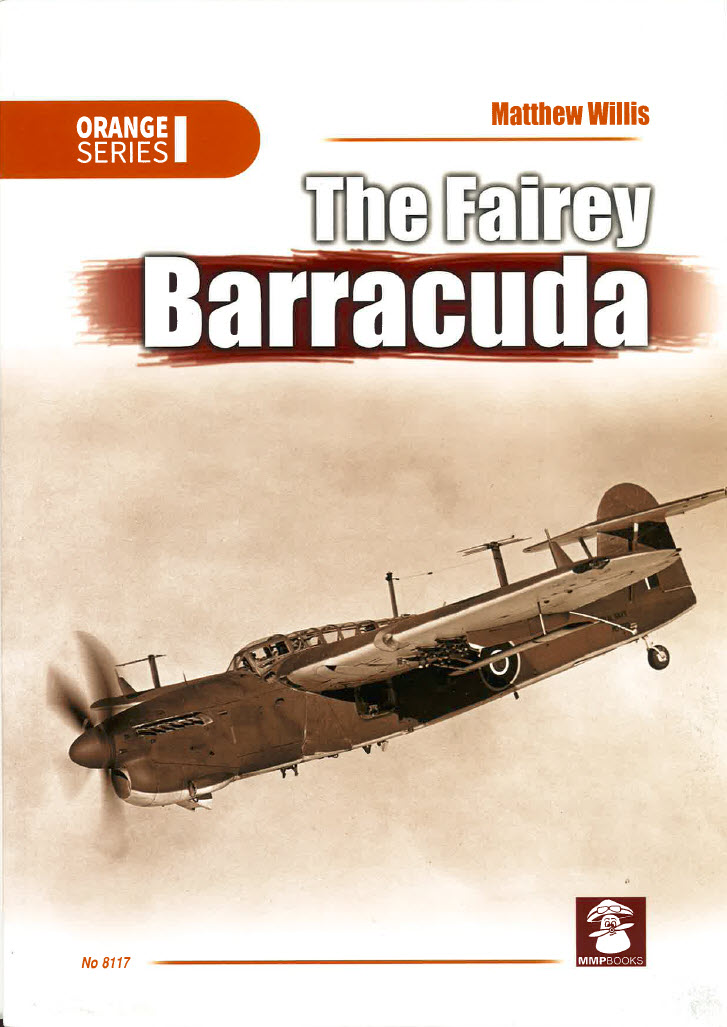The Fairey Barracuda
Matthew Willis was born in the historic naval town of Harwich, Essex in 1976. Matthew studied Literature and History of Science at the University of Kent, where he wrote an MA thesis on Joseph Conrad and sailed for the University in national competitions. He subsequently worked as a journalist for Autosport and F1 Racing magazines, before switching to a career with the National Health Service, where he wrote everything from press releases to consultation papers. His first non-fiction book, a history of the Blackburn Skua WW2 naval dive bomber, was published in 2007. He currently lives in Southampton with his University lecturer wife Rosalind, and writes both fiction and non-fiction for a living. This is Matthew Willis fifth book, and fourth with Mushroom Model Publications. Matthew has also been published in four short-story anthologies with author J. A. Ironside. He has also authored many feature articles in aviation and scale modeling magazines. You can find Mathew Willis on Facebook at https://www.facebook.com/daedalusandthedeep/ and follow him on Twitter at https://twitter.com/NavalAirHistory . He also has a blog at https://airandseastories.com for his fiction stories.
The Fairey Barracuda was a carrier torpedo and dive bomber that was designed to replace the Royal Navy Fleet Air Arm’s biplanes, the Fairey Swordfish and the Fairey Albacore. The Barracuda was designed to British Specification S.24/37 and made its first flight on December 7, 1940. Its primary competitor, the Supermarine Type 322’s first flight wasn’t till 1943 after the Barracuda was already in full production. The Barracuda was the FAA’s first all metal aircraft to fill this role, entering service on Janaury 10, 1943 with 827 Squadron. The Barracuda’s early service was plagued with a number of fatal crashes that gave the airplane an ill reputation. Interestingly, one of the biggest problems was with hydraulic leaks, with the most common leak being the pilot’s hydraulic pressure gauge. It wasn’t till 1945 that the mystery of the hydraulic fluid spraying into the pilot’s face was attributed to the hydraulic fluid containing ether. Over 2,600 Fairey Barracudas were delivered and sadly, not a single complete example of this aircraft has survived.
This tome provides some of the most thorough coverage on the Barracuda yet published. David Brown’s 1972 Aircraft Profile number 240 on the Barracuda provided 24 pages. Warpaint 35 covered the Barracuda authored by W.A. Harrison and was published in 2004 and clocked in at 36 pages. Ad Hoc Publications’ 2012 release from their ‘From the Cockpit’ series (number 16 by Robert McCandless) comes close with 144 pages, but unfortunately I don’t have a copy of it.
The Table of Contents includes the following sections:
- Acknowledgements
- Introduction
- ‘The Aeroplane Is To Be Presented For Examination’ - Background and Genesis
- The Powerplant Saga [Page 8]
- ‘A Certain Amount of Ill-Informed Criticism’ - Barracuda Development
- The Long Road To Readiness
- A New Production Scheme [Page 18]
- Production Testing, and Development Continues
- Barracuda (1/48 and 1/72) Scale Plans [Page 33]
- ‘A Very Hairy Sort of Business’ - The Barracuda Enters Service
- Rapid Build Up
- New Tactics and Methods
- Training
- Delivery
- Radar and Weight-Saving
- The Tirpitz and Shipping Strikes in the North Sea [Page 58]
- Hitting Hard in the East Indies
- ‘Cuda’ Floats [Page 72]
- ASW and Convoy Protection in European Waters
- Return to the East
- The Barracuda and the Griffon [Page 95]
- ‘Was Anyone Hurt in the Wreck?’ - Postwar Service [Page 111]
- Cold War Anti-Submarine Warfare
- ‘Special Duties’
- ‘Dropped Like A Stone’ - The Barracuda Assessed
- Performance and Power
- Agility
- Qualities As A Strike Aircraft
- Modern Features [Page 120]
- Safety
- Armament
- Deck Landing
- Conclusion
- ‘It Has Not Been Found Easy To Tool Up' - Technical Description
- Fuselage and Cockpit [Page 132]
- Wings
- Tail
- Control Surfaces
- Undercarriage
- Powerplant
- Equipment
- Armament
- Systems
- In Flight
- Fairey Barracuda Details
- ‘Epitomizing the Beauty of Naval Aviation’ - Barracuda Colours [Page 165]
- ‘Something Very Original’ - Postscript
One section that caught my attention was the one on ‘Cuda Floats’ [Page 72]. In preparation for Allied landings against Japan, trials were conducted at Boscombe Downs. Although not definitive, it appears that the containers at eight-feet in length, two-feet wide, and two-and-a-half feet in depth may have been meant to carry paratroopers since the evaluation was conducted with the Airborne Forces Experimental Establishment. Each ‘float’ had front and rear doors that were pilot operated. This effort did not proceed beyond testing, but I have to wonder about the sanity of a paratrooper willing to ride in this ‘float’ for literally hours only to wait until the pilot opens the ‘doors’ so they can parachute to their target. Maybe it could be a thrill ride at a theme park?
Special Hobby produces a nice mixed media 1/48 Mk.II and after-market companies make it possible to get to the Mk.III and Mk.V Barracuda. In 1/72, you get the old tried and true generic Barracuda Mk.II from Frog (Air Lines, UPC, Hasegawa, and Novo) kit along with a resin Planet Models kit of the Mk.5. MPM (Special Hobby) gets you a Mk.II and a Mk.III.
Matthew Willis has delivered a great history on the Fairey Barracuda that not only covers the development and operational history, but provides a good basis for the modeler with nice detail shots. I counted 219 black and white photographs. You also get 28 color plates from JP Vieira and 10 black and white scale drawings from Dariusz Karnas. Mushroom Model Publications’ has provided a page by page preview at: http://mmpbooks.biz/ksiazki/337 .
My thanks to Mushroom Model Publications and IPMS/USA for the chance to review this great book.
Highly recommended!













Comments
Add new comment
This site is protected by reCAPTCHA and the Google Privacy Policy and Terms of Service apply.
Similar Reviews